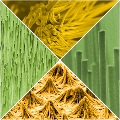Home > Press > Prevent Nanograss Collapsing
 |
Abstract:
The synthesis of several types of one-dimensional structures like nanowires, nanobelts, and nanotubes have recently attracted considerable interest. Because of their one-dimensional structure vertically aligned nanostructural arrays exhibit a much higher active surface than comparable thin film arrays.
Prevent Nanograss Collapsing
Germany | Posted on June 1st, 2011In particular, vertical aligned arrays of semiconductive nanostructures with a high length/diameter aspect ratio opens up a broad spectrum of novel applications. Uniform and free standing assembly of nanostructures are promising materials for photovoltaic or light emitting applications, due to their well defined channels working as carriers. One of the cost effective methods to achieve nantoubes or nanowires with high aspect ratios (HARs) is the template deposition method.
However, any HAR structures synthesized using any currently existing template method have the major disadvantage of these methods occurring during the separation of the nanostructures from the template. The higher the aspect ratio of length and diameter, the more the nanostructures tends to collapse into wheat-like structures.
At the Darmstadt University of Technology, Germany, M. Böhme and Professor Ensinger developed a novel process to inhibit the mechanism of collapsing nanostructures synthesized by template-based deposition. They succeeded in the controlled fabrication of nanograss-like and free standing nanostructures with a high length/ diameter aspect ratio.
Böhme and Ensinger used liquid CO2 as a treating agent instead of dichloromethane with its high surface energy leading the nanostructures across into an ambient with low surface energy. Thus they were capable of preventing the nanostructures collapsing during any step of operation. Significantly, this procedure provides a fundamental technique for all kinds of applications and devices based on one-dimensional HAR nanostructures.
####
For more information, please click here
Copyright © Wiley-VCH Materials Science Journals
If you have a comment, please Contact us.Issuers of news releases, not 7th Wave, Inc. or Nanotechnology Now, are solely responsible for the accuracy of the content.
| Related Links |
![]() M. Böhme and W. Ensinger, Adv. Eng. Mater. ; DOI: 10.1002/adem.201000346
M. Böhme and W. Ensinger, Adv. Eng. Mater. ; DOI: 10.1002/adem.201000346
| Related News Press |
News and information
![]() Researchers develop molecular qubits that communicate at telecom frequencies October 3rd, 2025
Researchers develop molecular qubits that communicate at telecom frequencies October 3rd, 2025
![]() Next-generation quantum communication October 3rd, 2025
Next-generation quantum communication October 3rd, 2025
![]() "Nanoreactor" cage uses visible light for catalytic and ultra-selective cross-cycloadditions October 3rd, 2025
"Nanoreactor" cage uses visible light for catalytic and ultra-selective cross-cycloadditions October 3rd, 2025
Nanotubes/Buckyballs/Fullerenes/Nanorods/Nanostrings
![]() Enhancing power factor of p- and n-type single-walled carbon nanotubes April 25th, 2025
Enhancing power factor of p- and n-type single-walled carbon nanotubes April 25th, 2025
![]() Chainmail-like material could be the future of armor: First 2D mechanically interlocked polymer exhibits exceptional flexibility and strength January 17th, 2025
Chainmail-like material could be the future of armor: First 2D mechanically interlocked polymer exhibits exceptional flexibility and strength January 17th, 2025
![]() Innovative biomimetic superhydrophobic coating combines repair and buffering properties for superior anti-erosion December 13th, 2024
Innovative biomimetic superhydrophobic coating combines repair and buffering properties for superior anti-erosion December 13th, 2024
Discoveries
![]() Researchers develop molecular qubits that communicate at telecom frequencies October 3rd, 2025
Researchers develop molecular qubits that communicate at telecom frequencies October 3rd, 2025
![]() Next-generation quantum communication October 3rd, 2025
Next-generation quantum communication October 3rd, 2025
![]() "Nanoreactor" cage uses visible light for catalytic and ultra-selective cross-cycloadditions October 3rd, 2025
"Nanoreactor" cage uses visible light for catalytic and ultra-selective cross-cycloadditions October 3rd, 2025
Announcements
![]() Rice membrane extracts lithium from brines with greater speed, less waste October 3rd, 2025
Rice membrane extracts lithium from brines with greater speed, less waste October 3rd, 2025
![]() Researchers develop molecular qubits that communicate at telecom frequencies October 3rd, 2025
Researchers develop molecular qubits that communicate at telecom frequencies October 3rd, 2025
![]() Next-generation quantum communication October 3rd, 2025
Next-generation quantum communication October 3rd, 2025
![]() "Nanoreactor" cage uses visible light for catalytic and ultra-selective cross-cycloadditions October 3rd, 2025
"Nanoreactor" cage uses visible light for catalytic and ultra-selective cross-cycloadditions October 3rd, 2025
|
|
||
|
|
||
| The latest news from around the world, FREE | ||
|
|
||
|
|
||
| Premium Products | ||
|
|
||
|
Only the news you want to read!
Learn More |
||
|
|
||
|
Full-service, expert consulting
Learn More |
||
|
|
||








